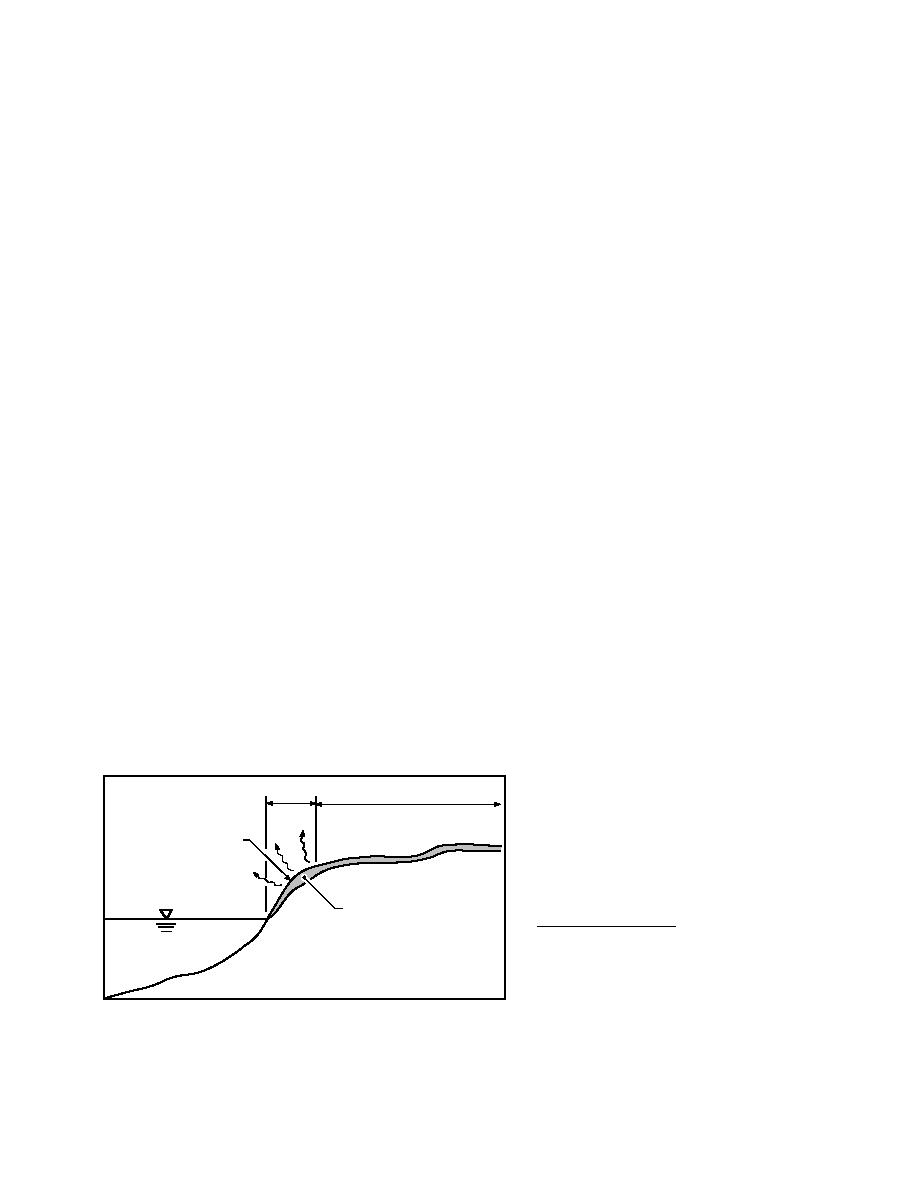
Usually air temperatures are not cold enough
The crest of a bank may also be snow-free more
for sufficiently long periods during the fall to
often than the lower parts of the bank (Fig. 5),
cause substantial soil water migration to the freez-
depending on wind conditions, which would en-
ing soil to form significant ground ice. Thus, the
hance heat loss at the crest as well. Snow insulates
amount of ground ice that thaws in the fall during
soil and thus inhibits frost penetration and re-
diurnal thaw periods would be much less than
tards soil thaw in the spring (Harlan and Nixon
that which thaws in the spring after an entire
1978), and its insulating effect is influenced by
winter. I conclude that the amount of bank soil
snow type, thickness, and density.
loss or instability that results from FTC in the fall
Reid (1985) found a difference in the frost depth
would be less than that which occurs due to spring
along north- and south-facing banks, as well: frost
thaw (Table 2).
was thicker in north-facing banks. Harlan and
Nixon (1978) concluded that south-facing banks
receive more insolation and thus do not freeze as
Winter
frequently, deeply, or completely as north-facing
Thickening of frozen soil
banks. Wuebben* points out that more diurnal
Once the average daily air temperature falls
FTC may occur in south-facing banks during that
below 32F and solar insolation is sufficiently low,
portion of the season when north-facing banks
the soil continues to lose heat to the atmosphere,
may remain frozen.
most soil thawing stops, and the zone of frozen soil
thickens (Table 2). A special condition exists along
Ground ice growth and frost heaving
an eroding bank (which is usually unvegetated)
Three conditions must exist for ground ice to
versus a stable, vegetated bank. Vegetation insu-
grow and become a substantial component of a
lates soil and reduces heat loss to the air, thereby
soil mass: a soil-moisture supply, sufficiently cold
reducing frost depth (McRoberts 1978) in a stable
air temperatures to cause soil heat loss and subse-
bank, while an eroding bank is likely to have greater
quent freezing, and a frost-susceptible soil, which
heat loss and deeper frost. The deeper frost makes
is usually a silty soil (Anderson et al. 1978). (Needle
more of the surface soil susceptible to erosion and
ice, however, will form in almost any type soil.†)
instability than would be in a vegetated bank.
Silty soils absorb moisture rapidly because they
Heat loss from soils at the crest of an eroding
have particles small enough to provide compara-
bank may even be greater than occurs from lower
tively high capillary rise and large enough to fur-
parts of a bank because heat is lost through the
nish voids of adequate size to allow quick flow of
upland land surface near the bank crest and
moisture through the silt, which leads to rapid
saturation of the voids of the soil (Jumikis 1962).
through the upper bank (Fig. 4). Reid's (1985) mea-
Coarse- and fine-grained soils do not absorb mois-
surements showed that the frozen zone of the
ture rapidly.
upland land surface landward of the crest of an
In addition to soil texture, soil frost susceptibil-
eroding bank was thicker near the bank face along
ity depends on, and varies with, vegetative cover
Orwell Reservoir in Minnesota, and thinned
and depth, thickness and density of snow cover,
landward away from the bank.
initial soil temperature, air temperature
regime, exposure to sun, the tempera-
Bank
Upland
ture gradient within the soil, the rate of
heat removal, the mobility of soil water,
the depth to the water table, overbur-
Zone of Enhanced Heat Loss
Through Upland Land Surface
den stress, and soil density (Chamber-
and Upper Bank Near Crest
lain 1981, Jumikis 1962).
Frozen Zone
* Personal communication with James L.
Unfrozen Zone
Wuebben, Research Hydraulic Engineer, Ice
Engineering Research Division, CRREL,
1994.
† Personal communication with Edwin J.
Figure 4. Bank crest zone with thickest frozen zone along a bank
Chamberlain, Jr., Research Civil Engineer,
profile.
Applied Research Division, CRREL, 1995.
7



 Previous Page
Previous Page
